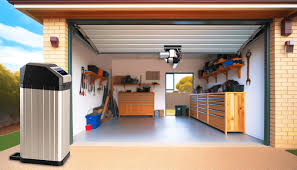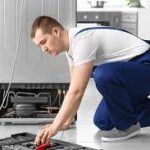A garage door is one of the most frequently used components of any home, opening and closing multiple times each day. Over time, wear and tear take a toll on the moving parts, leading to noisy operation, slower response, or even complete failure. When this happens, choosing the correct replacement parts becomes essential to maintaining safety, functionality, and longevity. However, with so many different types of springs, rollers, tracks, cables, and sensors on the market, making the right choice can be overwhelming. Understanding how each component works and how it impacts overall performance helps homeowners make smart decisions that keep their garage doors running smoothly for years.
Understanding the Role of Each Component
Before selecting replacement parts, it’s essential to understand the function of the main garage door components. The springs handle most of the lifting, making them one of the most critical parts to replace with precision. Incorrect spring size or tension can cause strain on the opener and lead to dangerous malfunctions. Rollers allow the door to glide smoothly along the track—when they become worn or damaged, the door may become noisy or unbalanced. Tracks guide the door’s movement and must stay properly aligned to prevent derailment. Cables keep everything synchronized, and if they fray or snap, the door can get stuck midway. Sensors ensure safety by detecting obstacles in the door’s path. Each part works together, so replacing only one without considering the others can create new issues. Taking time to understand the door’s design and how components interact ensures that replacement parts maintain optimal performance and safety over the long term.
Matching Parts to Your Door Type and Size
One of the most essential steps in choosing replacement parts is making sure they are compatible with your specific door. Garage doors come in different sizes, weights, and materials, and the components must be matched accordingly. For example, torsion springs are rated by cycle life and weight capacity, so a spring designed for a lightweight aluminum door won’t work correctly on a heavy wooden or insulated steel door. The same applies to rollers—nylon rollers offer quieter operation, while steel rollers provide extra strength. Homeowners should always verify the model number and manufacturer of their door before purchasing parts. When in doubt, measuring existing components or checking the original manual can help avoid costly mistakes. Many homeowners rely on professionals for guidance, especially when dealing with high-tension components. Companies that provide garage door repair in Vancouver, WA, by Lewis River Doors often assess the entire door system to ensure that every replacement part complements the door’s weight, design, and frequency of use. This careful matching prevents unnecessary failures and protects the system’s overall structure.
Evaluating Quality and Durability of Replacement Parts
Not all garage door parts are created equal, and choosing high-quality components can significantly improve performance and lifespan. Cheaper parts may seem appealing upfront, but they often wear out quickly and cause additional damage over time. For example, low-grade cables can fray sooner, and inferior rollers can break under stress. High-quality parts are typically made of durable materials, such as galvanized steel, reinforced nylon, or powder-coated components, which resist rust and corrosion. Stainless steel hinges and brackets provide long-term stability, especially in humid or coastal environments. Another indicator of quality is warranty coverage—reputable manufacturers offer more extended warranties, standing behind the durability of their parts. Even small components, such as bolts and fasteners, should be made from reliable materials to maintain structural integrity. Investing in better-quality parts not only enhances safety but also reduces the need for frequent repairs. Homeowners save time and money in the long run by prioritizing durability and performance over short-term savings.
Considering Safety Features and Modern Updates
Modern garage door systems often include advanced safety and convenience features that older models may lack. When replacing parts, it’s an excellent opportunity to upgrade to newer technologies. For instance, photo-eye sensors that stop the door when motion is detected can prevent accidents and protect children and pets. Soft-start openers reduce strain on the door and minimize noise. Advanced torsion springs with safety containment systems prevent dangerous spring recoil if one breaks. Homeowners may also consider high-cycle springs if they frequently open and close the door multiple times a day. Another popular upgrade is steel-reinforced cables that add strength and prevent snapping. In addition to mechanical upgrades, innovative technology has made its way into garage doors—wireless sensors, smartphone integration, and battery backup systems increase convenience and security. Choosing replacement parts that improve safety and modern functionality helps future-proof the door and gives homeowners greater control and peace of mind.
Determining When to Repair vs. Replace Entire Systems
Sometimes a failing component signals a larger issue within the system. Replacing just one part might not be enough to restore functionality. If the door is more than 15 to 20 years old, multiple components may be worn and approaching the end of their lifespan. Replacing the entire opener or upgrading the spring system may be more cost-effective than repeatedly fixing individual parts. Visible signs such as sagging panels, rusted hinges, or bent tracks may indicate deeper structural problems.
Additionally, if the door is noisy, slow, or uneven even after part replacement, it may need balancing or realignment. A thorough inspection by a trained technician can reveal whether the entire system needs attention. Homeowners should always factor in safety and long-term performance when deciding between minor repairs and full replacements. Making a strategic decision prevents ongoing maintenance headaches and ensures smooth, efficient operation.
Working with Professionals for Proper Installation
Even the highest-quality replacement parts won’t perform well if installed incorrectly. Garage door components, especially springs and cables, operate under high tension and can be dangerous to handle without proper tools and experience. Professional installation ensures that parts are installed safely, calibrated correctly, and balanced for smooth operation. Technicians measure spring tension, align tracks, and secure fasteners with precision, preventing future problems. They also test safety systems and lubricate moving parts to enhance durability. Many professional services offer warranties on both parts and labor, providing homeowners with extra protection. In addition, a trained technician can identify underlying issues that homeowners may overlook, preventing bigger breakdowns in the future. Collaborating with a professional ensures the replacement process is done correctly, extends the door’s lifespan, and maintains safe daily operation.
Read More: https://acubi.us/how-to-choose-between-a-probate-lawyer-and-an-estate-planning-attorney/
Choosing Smart for Long-Term Reliability
Your garage door is a significant entry point for your home and a crucial part of daily convenience. Choosing the right replacement parts is about more than fixing a problem—it’s about maintaining safety, efficiency, and durability. By understanding how each component functions, matching parts to your specific door, prioritizing quality, and considering safety upgrades, homeowners can make informed decisions that protect their investment. When needed, working with a skilled professional ensures proper installation and long-lasting performance. A well-maintained garage door adds value, improves security, and operates smoothly year after year. Making wise choices today helps ensure that your garage door remains reliable, quiet, and safe for the future.



